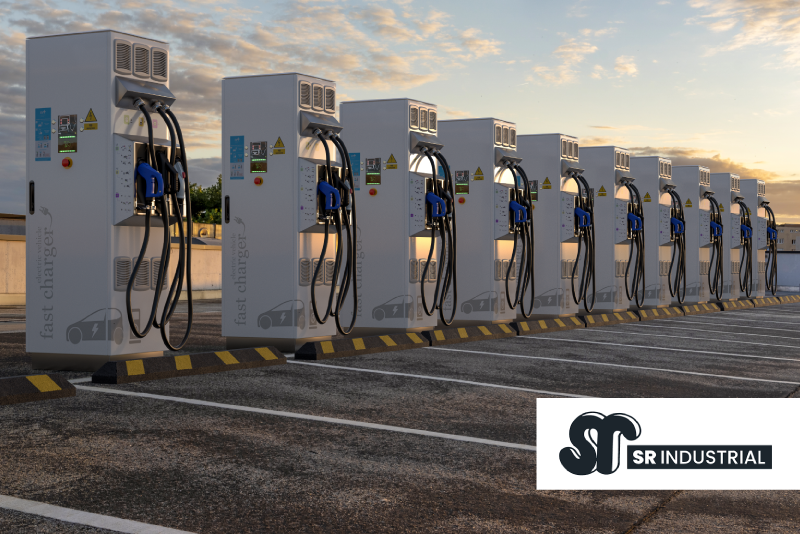Commercial Groundworks: A Comprehensive Guide to Efficient Project Execution

Introduction
Commercial groundworks form the foundation of successful construction projects. Whether it’s a commercial building, shopping centre, or industrial complex, proper planning and execution of groundworks are essential for a project’s long-term stability and functionality.
In this comprehensive guide, we will explore the key aspects of commercial groundworks and provide valuable insights to help you achieve efficient project execution. Let’s dive in!
Understanding Commercial Groundworks
Commercial groundworks encompass a range of activities necessary for preparing a construction site before building commences. These activities include excavation, drainage systems installation, landscaping, infrastructure development, and utilities installation. Each stage of groundworks plays a crucial role in creating a solid foundation and ensuring smooth project progress.
Types of Commercial Groundworks
Foundations and Excavations
Foundations provide stability and support to the structure above. Excavation involves removing soil and creating a level surface for construction.
Drainage Systems
Effective drainage systems prevent water accumulation and ensure the longevity of the building. They include surface drainage and subsurface drainage methods.
Landscaping and External Works
Landscaping enhances the aesthetic appeal of the project, while external works involve constructing roads, pavements, and other outdoor features.
Infrastructure and Utilities
Installing utility networks, such as water, electricity, and gas, ensures the availability of essential services for the commercial space.
Key Considerations for Commercial Groundworks
Site Assessment and Preparation
Clearing and Demolition
Before construction begins, clearing the site of any existing structures, vegetation, or debris is crucial. This creates a clean slate for the groundworks to commence.
Soil Investigation and Testing
Understanding the soil conditions is vital for determining the appropriate foundation design and construction methods. Conducting soil investigation and testing helps identify potential challenges and design solutions accordingly.
Regulatory and Legal Compliance
Building Regulations and Permits
Adhering to building regulations and obtaining necessary permits ensures compliance with safety standards and legal requirements.
Health and Safety Guidelines
Implementing robust health and safety protocols protects workers and ensures a safe working environment throughout the groundworks process.
Environmental Considerations
Addressing environmental concerns, such as water conservation and minimizing ecological impact, is essential for sustainable construction practices.
Planning and Design for Commercial Groundworks
Engaging with Architects and Engineers
Collaborative Design Process
Collaboration between architects, engineers, and groundworks specialists ensures efficient integration of design elements with the groundworks plan.
Ensuring Structural Integrity and Stability
Working closely with structural engineers guarantees that the groundworks plan aligns with the structural requirements of the project, providing a solid foundation.
Developing a Comprehensive Groundworks Plan
Understanding Project Requirements
Thoroughly comprehending the project’s goals and requirements allows for accurate planning and resource allocation.
Creating a Site Development Strategy
Developing a strategic approach to site development considers factors such as access, material delivery, and coordination with other trades.
Estimating Budget and Resources
Accurate budgeting and resource allocation help ensure the project stays on track financially and avoids delays due to resource shortages.
Execution and Project Management
Site Setup and Mobilisation
Temporary Structures and Facilities
Setting up temporary structures, such as site offices and welfare facilities, provides a comfortable working environment for the project team.
Logistics and Material Handling
Efficient logistics planning and material handling ensure the timely delivery and proper storage of construction materials, minimising delays.
Excavation and Earthworks
Techniques for Efficient Excavation
Using advanced equipment and techniques for excavation streamlines the process, saving time and resources.
Soil Stabilisation and Compaction
Proper soil stabilisation and compaction techniques enhance the soil’s load-bearing capacity, reducing the risk of settlement.
Slope and Retaining Wall Construction
Constructing slopes and retaining walls is necessary to manage changes in elevation and prevent soil erosion. Skilled professionals employ various techniques, including:
Retaining Wall Design
- Designing retaining walls that withstand soil pressure and provide stability.
- Incorporating drainage systems to prevent water build-up behind the walls.
Slope Reinforcement
- Implementing soil reinforcement techniques, such as geogrids or soil nails, to increase slope stability.
- Installing erosion control measures, such as erosion blankets or vegetation, to minimise soil erosion.
Drainage Systems Installation
Types of Drainage Systems
Effective drainage systems are crucial to prevent water accumulation and maintain a dry and stable site. Some commonly used drainage systems include:
Surface Drainage
- Installing gutters, channels, and catch basins to collect and redirect surface water away from the site.
- Constructing swales or ditches to facilitate the natural flow of water.
Subsurface Drainage
- Utilising French drains or perforated pipes to redirect excess groundwater away from the construction site.
- Installing sump pumps or drainage wells to manage water table levels.
Sustainable Water Management
Implementing sustainable water management practices in commercial groundworks is gaining importance. Some key considerations include:
Rainwater Harvesting
- Incorporating systems to collect and store rainwater for irrigation or non-potable water usage.
- Installing rain gardens or permeable pavements to allow water to infiltrate the ground.
Green Infrastructure
- Integrating green roofs or bioswales to manage stormwater runoff and promote biodiversity.
- Using sustainable landscaping practices that minimise water consumption.
Foundations and Structural Elements
Types of Foundations
Different types of foundations are used based on soil conditions, project requirements, and structural design. Some common foundation types include:
Strip Foundations
- Suitable for low-rise structures and evenly distributing loads along the foundation width.
- Reinforced with steel bars for added strength.
Raft Foundations
- Ideal for large or heavy structures, spreading loads over a wider area.
- Effective in areas with weak or variable soil conditions.
Pile Foundations
- Utilised when soil conditions are poor or to transfer loads to deeper, more stable layers.
- Various types of piles, such as driven piles or bored piles, can be used based on site conditions.
Reinforcement and Formwork
Reinforcing the foundation and structural elements is essential for their strength and durability. Key considerations include:
Steel Reinforcement
- Adding steel bars or mesh to concrete elements for increased tensile strength.
- Ensuring proper placement and spacing of reinforcement according to structural design.
Formwork Systems
- Constructing temporary formwork to shape concrete during pouring and curing.
- Using reusable formwork systems for cost and time efficiency.
Concrete Pouring and Curing
Proper concrete pouring and curing techniques are crucial for achieving strong and durable structures. Important factors to consider are:
Concrete Mixing and Placement
- Ensuring accurate proportions of cement, aggregates, and water.
- Using appropriate equipment for efficient concrete placement.
Curing Methods
- Implementing curing techniques, such as covering with plastic or applying curing compounds, to maintain optimal moisture levels.
- Allowing sufficient curing time to achieve the desired strength and durability.
Landscaping and External Works
Surface Finishes and Pavements
Selecting suitable surface finishes and pavements enhance the functionality and aesthetics of the commercial space. Considerations include:
Paving Materials
- Choosing durable and visually appealing materials such as concrete, asphalt, or paving stones for walkways, parking lots, and outdoor areas.
- Considering factors like slip resistance, maintenance requirements, and sustainability.
Surface Treatments
- Applying sealants or coatings to protect surfaces from weathering, stains, or wear.
- Incorporating decorative elements like stamped patterns or coloured finishes for added visual appeal.
Green Spaces and Planting
Integrating green spaces and planting adds beauty and environmental benefits to commercial projects. Here are some considerations:
Landscape Design
- Collaborating with landscape architects to create functional and aesthetically pleasing outdoor spaces.
- Incorporating elements like lawns, trees, shrubs, and flower beds to enhance the overall environment.
Irrigation Systems
- Installing efficient irrigation systems, such as drip irrigation or smart controllers, to minimise water usage.
- Incorporating rain sensors or moisture sensors for optimised watering schedules.
Street Furniture and Lighting
Street furniture and lighting contribute to the usability and safety of commercial areas. Key aspects include:
Furniture Selection
- Choosing durable and comfortable seating, waste bins, bike racks, and other amenities.
- Considering design cohesion with the overall aesthetic of the project.
Lighting Design
- Planning lighting solutions for pedestrian walkways, parking areas, and building entrances.
- Incorporating energy-efficient LED fixtures and considering lighting levels for security and ambiance.
- Infrastructure and Utilities
Utility Network Installation
Installing essential utility networks ensures the functionality of commercial spaces. Consider the following:
Water Supply
- Connecting to the municipal water supply or drilling wells for self-sufficiency.
- Ensuring proper plumbing installation and backflow prevention measures.
Electricity and Gas
- Coordinating with utility providers for electrical and gas connections.
- Implementing proper wiring and safety measures in compliance with regulations.
Trenching and Ducting
Trenching and ducting enable the installation and maintenance of underground utilities. Important aspects include:
Excavation and Trenching
- Digging trenches to accommodate utility pipes or cables.
- Ensuring proper depth, width, and slope for effective utility placement.
Ducting Systems
- Installing conduits or ducts for organized and protected routing of utility lines.
- Considering future expansion or upgrades in the design of ducting systems.
Access Points and Maintenance
Providing convenient access points and planning for maintenance activities are vital for utility management. Consider:
Utility Access Covers
- Installing manhole covers, inspection chambers, or valve boxes for easy access to utilities.
- Ensuring secure and durable covers to prevent unauthorised entry and protect infrastructure.
Maintenance Considerations
Designing utility layouts that facilitate routine maintenance and repairs.
Incorporating access routes and space for equipment required during maintenance activities.
Quality Control and Safety Measures
Ensuring Compliance with Specifications
Regular monitoring and inspection guarantee that the commercial groundworks align with project specifications. Consider:
Quality Assurance
- Implementing quality control processes to verify compliance with design and construction standards.
- Conducting inspections at various stages to detect and rectify any deviations.
Testing and Certification
- Performing necessary tests, such as soil compaction tests or concrete strength tests.
- Obtaining certifications from authorised bodies to ensure adherence to regulatory requirements.
Managing Risk and Ensuring Safety
Prioritizing safety throughout the groundworks process is crucial for the well-being of workers and the success of the project. Consider:
- Hazard Identification and Risk Assessment
- Identifying potential hazards and assessing associated risks.
- Implementing measures to mitigate risks and ensure a safe working environment.
Implementing Safety Procedures and Protocols
- Establishing comprehensive safety protocols, including personal protective equipment (PPE) requirements and safe work practices.
- Conducting regular safety training sessions and maintaining open communication regarding safety concerns.
- Completing Commercial Groundworks Projects
Site Handover and Client Acceptance
Final Inspections and Certifications
Conducting thorough final inspections and obtaining necessary certifications are critical steps before project handover. Consider:
Structural Inspections
- Engaging structural engineers to assess the integrity and safety of the completed groundworks.
- Addressing any outstanding issues or deficiencies identified during the inspection process.
Compliance Certifications
- Obtaining certificates of compliance with building regulations, environmental standards, and health and safety guidelines.
- Ensuring all required documentation is in order for a smooth handover to the client.
Documenting As-Built Drawings
Creating accurate as-built drawings documenting the completed groundworks is essential for future reference. Key considerations include:
Updating Plans and Drawings
- Incorporating any modifications or deviations from the initial design into the as-built drawings.
- Ensuring accuracy and clarity in depicting the final groundworks layout.
Maintenance and Operation Manuals
- Providing comprehensive documentation outlining maintenance requirements and operational guidelines for the completed infrastructure.
Maintenance and Long-Term Considerations
Routine Maintenance Requirements
Regular maintenance ensures the longevity and optimal performance of commercial groundworks. Consider the following:
Maintenance Schedules
- Establishing scheduled maintenance activities for different components, such as drainage systems, landscaping, and utilities.
- Conducting inspections, cleaning, and repairs as per the maintenance plan.
Preventive Measures
- Implementing preventive maintenance strategies to identify and address potential issues before they escalate.
- Regularly monitoring and maintaining drainage systems to prevent blockages and ensure efficient water management.
Future Expansion and Adaptation
Anticipating future needs and considering flexibility in design is essential for commercial spaces. Factors to consider include:
Design Considerations
Allowing for scalability and adaptability in the initial groundworks design to accommodate future expansions or modifications.
Incorporating infrastructure and utility provisions to support future requirements.
Collaboration with Specialists
Consulting with professionals experienced in commercial renovations and expansions to ensure seamless integration with existing groundworks.
Conclusion
In conclusion, efficient execution of commercial groundworks is crucial for successful construction projects. By understanding the key considerations, planning and designing meticulously, executing with precision, prioritising quality control and safety, and considering long-term maintenance and future needs, you can achieve a solid foundation for your commercial venture. Engaging experienced professionals like SR Industrial will ensure that your commercial groundworks are carried out to the highest standards, resulting in a functional, safe, and visually appealing environment.
Embrace the power of well-executed groundworks to set the stage for your commercial success.


